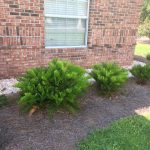
When designing landscapes, it is popular to create lines and masses of plants for high visual impacts. Plants are carefully selected to be similar in size and shape at the time of installation. They are all grouped together, so they must be getting the same care, but why do they look different years later? There are several factors to consider when we are trying to figure out why a perfectly matched set no longer looks like a uniform planting.
Although plants may be in the same bed, shadows cast at certain times of the day may reduce sunlight to some sections and not others. This can be caused by structures or trees that have grown over time and changed light patterns.
Supplemental irrigation may also be variable even with the best system design. Over time plants grow and may block sprinkler emitters from reaching some sections of landscape beds. Even if the landscape relies on natural rainfall, there can be still be dry/wet spots in the landscape due to drainage off of hard structures, low areas, or wind direction during storms.
It might be possible to adjust some lighting and watering issues, but there is one factor that many gardeners have not considered – genetics. If plants were grown from seed, than variation is not only possible, but likely. This might be displayed as differences in height and width, foliage color, flower color, speed of growth – all may be influenced by parentage despite best efforts to care for each plant similarly.
Many landscape plants are cultivars. This means they are grown from cuttings or divisions which make them identical to the original plant. When a plant is grown from seed, however, there is no guarantee it will have the same specific qualities as the mother plant.
To combat this phenomenon, landscapers should check sunlight and watering for irregular growth patterns and adjust if needed. If a landscape design requires uniform plants, use named cultivars rather than seedling grown plants in lines or masses.
 0
0
